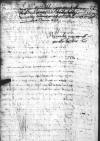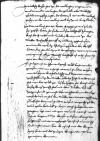Dem Erwirdigen in Got, unnserm besondernn gelibten Freunde unnd Nachparn, / hern ⌊Johansen bischoffen zw Ermlandt⌋
Hochwirdiger in Got, fielgeliebter Her, Freund und Nachpar.
Euer Lieb sein mein gantz freuntliche dinst, wes ich auch iederzeit mer liebs und guts guts vermage sampt gotlicher gnaden und aller seligkeit wunschung zuvor.
Euer Lieb eigen ⌊⌋, datis ⌊Helspergk⌋ den 8 Novembris hab ich amb 1538-11-11⌊dag Martini1538-11-11⌋ kegen der nacht zu ⌊Fischhausen⌋ entphangen, verlesen und eingenomen welchs ich langlichen zuerwydern denn an not achte. Ins erst aber hab ich aus derselben Euer Lieb ⌊⌋ gancz ungern vermerckt, das dy sollich nicht in reichern vorrat den wy angezeiget sitzen hette auch in warheit viell ein anders gemeinet. Wy dem so wil ich hoffen es werd sich in allen Euer Lieb thun an ere, rumb und vermogen durch dy gnade Gottes und Euer Lieb hochen verstandt und geschicklichkeit als eins verstendigen guten wortes alles wy ich iederzeit [da]fur erfrewet begerlich richtiglichen meren und zunemen thu mich auch hievonen Euer Lieb freuntlich gutwilli...gs gemutes, das auch diselbig geren pey ir gesehen gantz freuntlich und als volkumen ab ich pey der selbigen gewesen bedancken. Wunnsche auch Euer Lieb zu disem iren cristlichen furhabenden wercke samt iren gantzen haus den reichlichen segen Gottes alle gluckselige wolfart und in uns allen cristliche erkantnus und wil Euer Lieb begern nach in alle weg nicht anderst kegen Euer Lieb als der freunt und gute nachpar in aller freuntschafft erfunden werden wy ich mich auch des kegen Euer Lieb gentzlichen verstrosten und versehen will.
Ich schick auch hiemit Euer Lieb etzliche newe zeitung, so mir diser dag zukumen in welchem mir amb erfrewlichsten ist dy gesuntheit des loblichen cristlichen frumen und heiligen ⌊kunigs⌋ unsse
<r>
aller gnedigsten hern dy wolle Got von dag zu dag meren und den loblichen konig uns allen seinen getrewen unttersassen langwirich fristen und erhalten amen, ihn Euer Lieb hiemit sampt erpitung aller freuntlichen gutwilligkeit dem almechtigen vor allem ubel zubehuten auch in gluckseliger zumeinung wes regements lang gesunt zuerhochen befelen. Des gleichen mein geliebste ⌊gemahel⌋ sich kegen Euer Lieb des erpitens des innigen gepetes und freuntlichen dinstes auch thut bedancken mit wider erpittung, wo Euer Lieb sundlichen gepetes auch aller gepur lehen f...schafft und gewis sich Euer Lieb befelen befelet(!) auch Euer Lieb wy ... vermelden.
Datis gantz abends ⌊Konigsperck⌋, den [14] Novembris anno 1538.
⌊Abrecht marggraff in ⌊Preussen⌋, herczog⌋ etc.
Enclosure:
Neue zeitung vom ⌊Turcken⌋
Der ⌊turckisch keÿser⌋ hat ja die ⌊Wallacheÿ⌋ eingenomen, / unnd ein ander Walachen der geburdt, / aber Turkischs glaubens eingesezt, / achten die botten so von ander Wallachen hie seyn, / er der new Wallach werd bey in nit lang bleiben. / Der new Wallach hat ein botten hie gehapt umb gleidt / seÿn grossen botten, / hie friden und freundtschafft zumachen / ⌊koniglicher maiestat⌋ bot ist wider aus ⌊Turckey⌋ komen, / mit in des ⌊Turcken⌋ batschafft hat uff 21 audienz gehapt / seÿn comunia die werbung bestetigung fridens, / den kauffleutten frey handlung und der gleichen was in primato weis ich nicht. / Eÿn Thatrisch batschafft ist auch hie / auch eÿne von den ⌊Mosquitter⌋. / In ⌊Hungern⌋ ist ein schon und gross volck beyeinander gewesenn, / wie man anzeigt / etwas ob hundert tausent / man / vil feÿner knecht Teutzsch und Spanier, / was gross hoffnung dem ⌊Turcken⌋ abbruch zuthun, / under einest hat man des volck gen lassen / ziehen hie knecht durch / die sag ⌊konig Janisch⌋ hab mit dem Turcken bess uff ⌊Jorgi⌋ anstandt gemacht. / Aber ein schreiben ander tags weiss davon, / er hab dem ⌊Turcken⌋ von newem geschworn / sol uff Oster dreÿ mol hundert tausent ungerisch gulden tribut geben, / der Turck in beÿm reich zuerhalten versprochenn, / legt man nit gar wol aus, / was ist wirdt sich nit bergenn. / Mÿt ⌊keÿser⌋ und ⌊Franckreich⌋ verfolgts also wie var angezeigt. / Sunst ist aus welschland nichts newes. / ⌊Romische konigliche maiestet⌋ ist mit der ⌊kongin⌋, zweÿ ⌊sonen⌋ und der ⌊jungen konigin von Polenn⌋ gen ⌊Wyenn⌋ kommen. /




